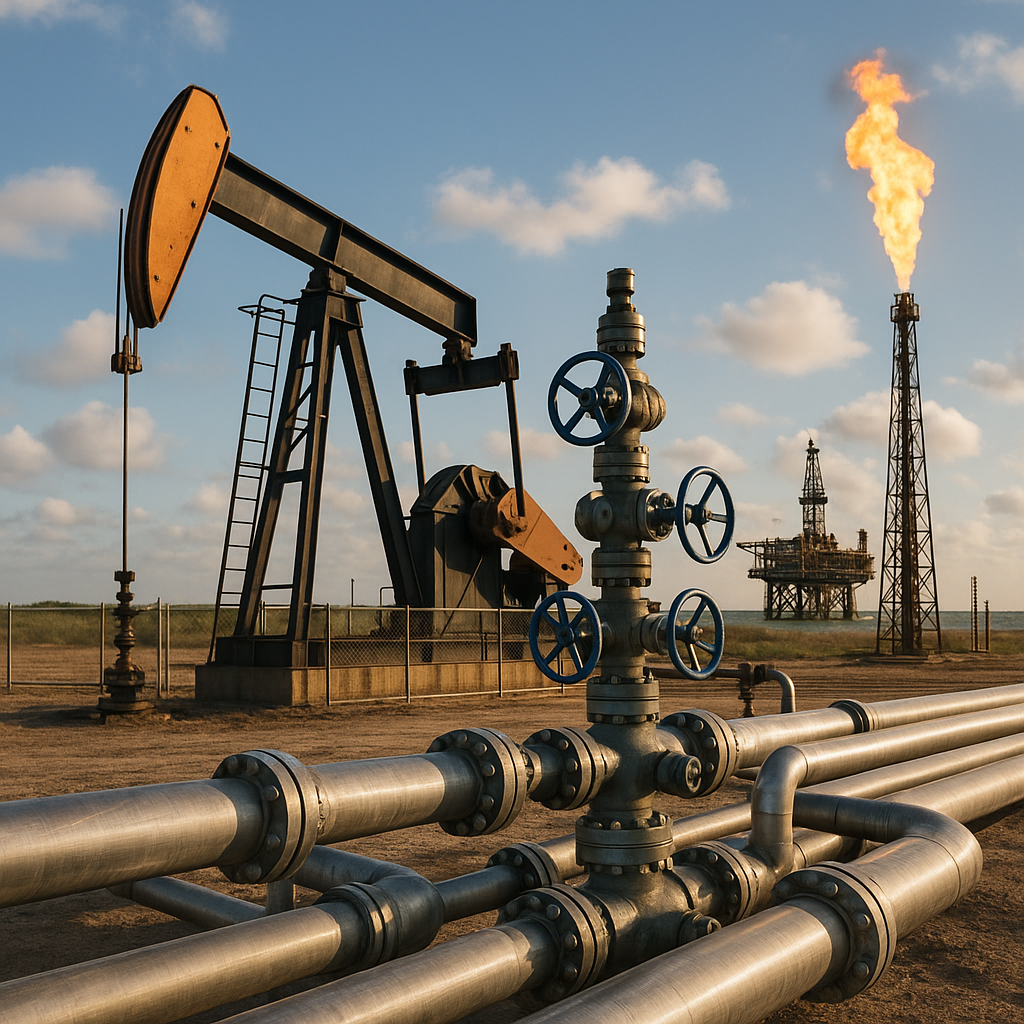The oil and gas industry is one of the most crucial and influential sectors in the global economy. It has powered industrial development, transportation, and economic growth for over a century. From the vehicles we drive to the electricity we use and the products we consume daily, oil and gas play a central role. Despite growing environmental concerns and a global push toward renewable energy, the oil and gas sector remains indispensable. This article explores the components of the industry, key players, technological innovations, challenges, and its evolving role in the future of global energy.
1. Understanding the Industry: Upstream, Midstream, and Downstream
The oil and gas industry is traditionally divided into three major sectors:
Upstream This segment involves the exploration and production (E&P) of oil and natural gas. Companies search for underground or underwater oil and gas fields, drill exploratory wells, and extract raw materials. Leading firms in this segment include ExxonMobil, Chevron, BP, Shell, and TotalEnergies.
Midstream Midstream operations focus on the transportation and storage of crude oil and natural gas. This includes pipelines, tanker ships, rail transport, and storage facilities. Midstream companies ensure the safe and efficient delivery of extracted materials from the production site to refineries and processing plants. Prominent players include Kinder Morgan, Enbridge, and Williams Companies.
Downstream The downstream sector includes refining crude oil into usable products such as gasoline, diesel, jet fuel, heating oil, and petrochemicals. It also covers marketing and distribution to consumers and businesses. Downstream operations are essential in delivering finished energy products to end users.
2. Key Products and Their Uses
The oil and gas industry supplies a broad range of essential products:
Crude Oil: The base raw material for a wide variety of refined products.
Natural Gas: Used for heating, electricity generation, and as feedstock for chemicals.
Refined Products:
Gasoline and Diesel: Fuels for vehicles and transportation.
Jet Fuel: Essential for aviation.
Liquefied Petroleum Gas (LPG): Used in heating and cooking.
Asphalt: For road construction.
Petrochemicals: Used to manufacture plastics, synthetic rubber, detergents, fertilizers, and more.
3. Major Oil-Producing Countries
Several countries dominate global oil production, often influencing market prices and geopolitical dynamics. As of 2024, the top producers include:
United States
Saudi Arabia
Russia
Canada
Iraq
United Arab Emirates
Iran
Many of these nations are members of OPEC (Organization of the Petroleum Exporting Countries), which coordinates oil production policies to stabilize global markets.
4. Challenges Facing the Industry
Despite its global importance, the oil and gas industry faces numerous challenges:
Price Volatility Oil and gas prices are subject to rapid changes driven by geopolitical events, supply-demand imbalances, OPEC policies, and market speculation. Sudden fluctuations can significantly affect profitability and investment strategies.
Environmental Concerns The industry is under pressure to reduce its environmental impact. Oil spills, greenhouse gas emissions, and methane leaks have raised public concern. Governments and regulatory bodies are enforcing stricter environmental regulations.
Political and Regulatory Risks Nationalization of resources, trade sanctions, and changing political climates can disrupt operations. For example, sanctions on oil-exporting countries can alter global supply chains.
Energy Transition The shift toward clean energy is reshaping the industry. Global agreements like the Paris Climate Accord are compelling oil and gas companies to reduce emissions and invest in low-carbon alternatives.
5. Technological Innovations Driving Progress
To stay competitive and reduce environmental impact, the industry has adopted several advanced technologies:
Hydraulic Fracturing (Fracking): Revolutionized U.S. shale oil and gas production by enabling access to previously inaccessible reserves.
3D Seismic Imaging: Enhances the accuracy of locating oil and gas reservoirs, reducing drilling risks.
Automation and AI: Used for predictive maintenance, reservoir modeling, and optimizing production.
Liquefied Natural Gas (LNG): Enables long-distance natural gas transport, expanding global market access.
Carbon Capture and Storage (CCS): Helps reduce CO2 emissions by capturing and storing it underground.
6. Career Opportunities in Oil and Gas
The industry offers diverse and high-paying career paths:
Petroleum Engineers: Design and manage drilling operations.
Geologists and Geophysicists: Identify potential resource locations.
Process Engineers: Improve efficiency in refining and chemical production.
HSE Officers: Ensure health, safety, and environmental compliance.
Drilling Supervisors: Oversee field operations.
Project Managers and Analysts: Plan and manage infrastructure and investment.
Despite the industry’s volatility, demand for skilled professionals remains high, especially in areas of innovation and sustainability.
7. Sustainability and the Future of Oil and Gas
The industry is at a turning point. While fossil fuels remain vital, companies are under increasing pressure to align with sustainability goals and diversify their energy portfolios.
Decarbonization: Many firms are investing in carbon-neutral technologies, improving energy efficiency, and offsetting emissions.
Renewable Integration: Oil majors are investing in wind, solar, and green hydrogen projects to diversify revenue and reduce dependence on fossil fuels.
Digital Transformation: Advanced analytics, IoT, and machine learning are streamlining operations and enhancing safety.
Policy and Regulation: International climate agreements and domestic regulations are pushing companies toward cleaner operations.
Public Perception: Increasing awareness of climate change has altered consumer and investor expectations, leading to greater scrutiny of oil and gas practices.
8. The Global Energy Outlook
Despite growth in renewables, global energy demand continues to rise, especially in developing economies. The International Energy Agency (IEA) predicts that oil and natural gas will still account for a significant portion of global energy consumption through 2040, albeit with a decreasing share.
Companies that embrace innovation, diversify energy sources, and commit to environmental responsibility are better positioned for long-term success.
Conclusion
The oil and gas industry remains a pillar of the global economy, providing energy, employment, and essential products that fuel our daily lives. However, it is also a sector in transformation. Facing environmental, economic, and political pressures, the industry is adapting through innovation and investment in sustainable practices. As the world moves toward a low-carbon future, the oil and gas sector will continue to play a vital—though evolving—role in meeting the world’s energy needs.
Its legacy is one of immense contribution to global development, and its future will depend on how effectively it navigates the challenges and opportunities of the 21st century.



